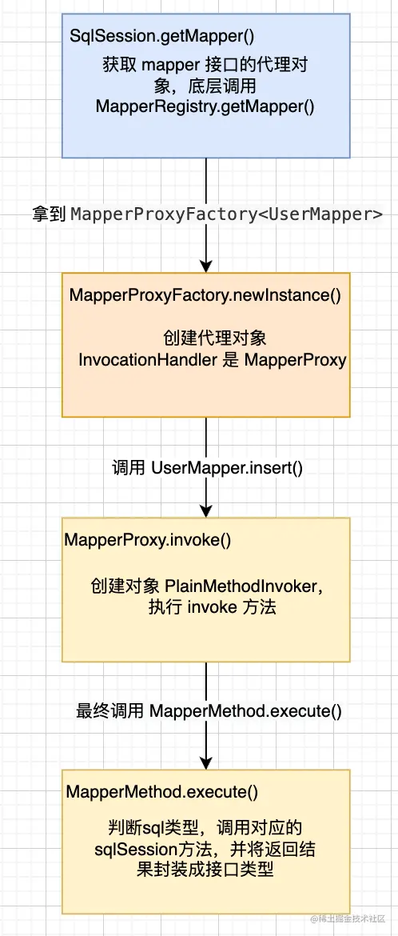使用过 mybatis 框架的小伙伴们都知道,mybatis 是个半 orm 框架,通过写 mapper 接口就能自动实现数据库的增删改查,但是对其中的原理一知半解,接下来就让我们深入框架的底层一探究竟
一、环境搭建
首先引入 mybatis 的依赖,在 resources 目录下创建 mybatis 核心配置文件 mybatis-config.xml
<?xml version="1.0" encoding="UTF-8" ?><!DOCTYPE configuration PUBLIC "-//mybatis.org//DTD Config 3.0//EN" "https://mybatis.org/dtd/mybatis-3-config.dtd"><configuration>
<!-- 环境、事务工厂、数据源 --> <environments default="dev"> <environment id="dev"> <transactionManager type="JDBC"/> <dataSource type="UNPOOLED"> <property name="driver" value="org.apache.derby.jdbc.EmbeddedDriver"/> <property name="url" value="jdbc:derby:db-user;create=true"/> </dataSource> </environment> </environments>
<!-- 指定 mapper 接口--> <mappers> <mapper class="com.myboy.demo.mapper.user.UserMapper"/> </mappers>
</configuration>
复制代码
在 com.myboy.demo.mapper.user 包下新建一个接口 UserMapper:
public interface UserMapper {
UserEntity getById(Long id);
void insertOne(@Param("id") Long id, @Param("name") String name, @Param("json") List<String> json);}
复制代码
在 resources 的 com.myboy.demo.mapper.user 包下创建 UserMapper.xml:
<?xml version="1.0" encoding="UTF-8" ?><!DOCTYPE mapper PUBLIC "-//mybatis.org//DTD Mapper 3.0//EN" "https://mybatis.org/dtd/mybatis-3-mapper.dtd"><mapper namespace="com.myboy.demo.mapper.user.UserMapper">
<select id="getById" resultType="com.myboy.demo.db.entity.UserEntity"> select * from demo_user where id = #{id} </select>
<insert id="insertOne"> insert into demo_user (id, name, json) values (#{id}, #{name}, #{json}) </insert></mapper>
复制代码
创建 main 方法测试:
try(InputStream in = Resources.getResourceAsStream("com/myboy/demo/sqlsession/mybatis-config.xml")){ SqlSessionFactory sqlSessionFactory = new SqlSessionFactoryBuilder().build(in); sqlSession = sqlSessionFactory.openSession(); # 拿到代理类对象 UserMapper mapper = sqlSession.getMapper(UserMapper.class); # 执行方法 UserEntity userEntity = mapper.getById(2L); System.out.println(userEntity); sqlSession.close();}catch (Exception e){ e.printStackTrace();}
复制代码
二、动态代理类的生成
通过上面的示例,我们需要思考两个问题:
mybatis 如何生成 mapper 的动态代理类?
通过 sqlSession.getMapper 获取到的动态代理类是什么内容?
通过查看源码,sqlSession.getMapper() 底层调用的是 mapperRegistry 的 getMapper 方法:
public <T> T getMapper(Class<T> type, SqlSession sqlSession) { // sqlSessionFactory build 的时候,就已经扫描了所有的 mapper 接口,并生成了一个 MapperProxyFactory 对象 // 这里根据 mapper 接口类获取 MapperProxyFactory 对象,这个对象可以用于生成 mapper 的代理对象 final MapperProxyFactory<T> mapperProxyFactory = (MapperProxyFactory<T>) knownMappers.get(type); if (mapperProxyFactory == null) { throw new BindingException("Type " + type + " is not known to the MapperRegistry."); } try { // 创建代理对象 return mapperProxyFactory.newInstance(sqlSession); } catch (Exception e) { throw new BindingException("Error getting mapper instance. Cause: " + e, e); } }
复制代码
代码注释已经写的很清楚,每个 mapper 接口在解析时会对应生成一个 MapperProxyFactory,保存到 knownMappers 中,mapper 接口的实现类(也就是动态代理类)通过这个 MapperProxyFactory 生成,mapperProxyFactory.newInstance(sqlSession) 代码如下:
/** * 根据 sqlSession 创建 mapper 的动态代理对象 * @param sqlSession sqlSession * @return 代理类 */public T newInstance(SqlSession sqlSession) { // 创建 MapperProxy 对象,这个对象实现 InvocationHandler 接口,里面封装类 mapper 动态代理方法的执行的核心逻辑 final MapperProxy<T> mapperProxy = new MapperProxy<>(sqlSession, mapperInterface, methodCache); return newInstance(mapperProxy);}
protected T newInstance(MapperProxy<T> mapperProxy) { return (T) Proxy.newProxyInstance(mapperInterface.getClassLoader(), new Class[] { mapperInterface }, mapperProxy);}
复制代码
代码一目了然,通过 jdk 动态代理技术创建了 mapper 接口的代理对象,其 InvocationHandler 的实现是 MapperProxy,那么 mapper 接口中方法的执行,最终都会被 MapperProxy 增强
三、MapperProxy 增强 mapper 接口
MapperProxy 类实现了 InvocationHandler 接口,那么其核心方法必然是在其 invoke 方法内部:
/** * 所有 mapper 代理对象的方法的核心逻辑 */@Overridepublic Object invoke(Object proxy, Method method, Object[] args) throws Throwable { try { // 如果执行的方法是 Object 类的方法,则直接反射执行 if (Object.class.equals(method.getDeclaringClass())) { return method.invoke(this, args); } else { // 1、根据method创建方法执行器对象 MapperMethodInvoker,用于适配不同的方法执行过程 // 2、执行方法逻辑 return cachedInvoker(method).invoke(proxy, method, args, sqlSession); } } catch (Throwable t) { throw ExceptionUtil.unwrapThrowable(t); }}
复制代码
3.1、cachedInvoker(method)
由于 jdk8 对接口增加了 default 关键字,使接口中的方法也可以有方法体,但是默认方法和普通方法的反射执行方式不同,需要用适配器适配一下才能统一执行,具体代码如下:
/** * 适配器模式,由于默认方法和普通方法反射执行的方式不同,所以用 MapperMethodInvoker 接口适配下 * DefaultMethodInvoker 用于执行默认方法 * PlainMethodInvoker 用于执行普通方法 */private MapperMethodInvoker cachedInvoker(Method method) throws Throwable { try { return MapUtil.computeIfAbsent(methodCache, method, m -> { // 返回默认方法执行器 DefaultMethodInvoker if (m.isDefault()) { try { if (privateLookupInMethod == null) { return new DefaultMethodInvoker(getMethodHandleJava8(method)); } else { return new DefaultMethodInvoker(getMethodHandleJava9(method)); } } catch (IllegalAccessException | InstantiationException | InvocationTargetException | NoSuchMethodException e) { throw new RuntimeException(e); } } // 返回普通方法执行器,只有一个 invoke 执行方法,实际上就是调用 MapperMethod 的执行方法 else { return new PlainMethodInvoker(new MapperMethod(mapperInterface, method, sqlSession.getConfiguration())); } }); } catch (RuntimeException re) { Throwable cause = re.getCause(); throw cause == null ? re : cause; }}
复制代码
如果判定执行的是接口的默认方法,则原始方法封装成 DefaultMethodInvoker,这个类的 invoke 方法就是利用反射调用原始方法,没什么好说的。
如果是普通的接口方法,则将方法封装成封装成 MapperMethod,然后再将 MapperMethod 封装到 PlainMethodInvoker 中,PlainMethodInvoker 没什么好看的,底层的执行方法还是调用 MapperMethod 的执行方法,至于 MapperMethod,咱们放到下一章来看
3.2、MapperMethod
首先看下构造方法:
public MapperMethod(Class<?> mapperInterface, Method method, Configuration config) { // 通过这个 SqlCommand 可以拿到 sql 类型和sql 对应的 MappedStatement this.command = new SqlCommand(config, mapperInterface, method); // 包装了 mapper 接口的一个方法,可以拿到方法的信息,比如方法返回值类型、返回是否集合、返回是否为空 this.method = new MethodSignature(config, mapperInterface, method);}
复制代码
代码里的注释写的很清楚了,MapperMethod 构造方法创建了两个对象 SqlCommand 和 MethodSignature。
mapper 接口的执行核心逻辑在其 execute() 方法中:
/** * 执行 mapper 方法的核心逻辑 * @param sqlSession sqlSession * @param args 方法入参数组 * @return 接口方法返回值 */ public Object execute(SqlSession sqlSession, Object[] args) { Object result; switch (command.getType()) { case INSERT: { // 参数处理,单个参数直接返回,多个参数封装成 map Object param = method.convertArgsToSqlCommandParam(args); // 调用 sqlSession 的插入方法 result = rowCountResult(sqlSession.insert(command.getName(), param)); break; } case UPDATE: { Object param = method.convertArgsToSqlCommandParam(args); result = rowCountResult(sqlSession.update(command.getName(), param)); break; } case DELETE: { Object param = method.convertArgsToSqlCommandParam(args); result = rowCountResult(sqlSession.delete(command.getName(), param)); break; } case SELECT: if (method.returnsVoid() && method.hasResultHandler()) { // 方法返回值为 void,但是参数里有 ResultHandler executeWithResultHandler(sqlSession, args); result = null; } else if (method.returnsMany()) { // 方法返回集合 result = executeForMany(sqlSession, args); } else if (method.returnsMap()) { // 方法返回 map result = executeForMap(sqlSession, args); } else if (method.returnsCursor()) { // 方法返回指针 result = executeForCursor(sqlSession, args); } else { // 方法返回单个对象 // 将参数进行转换,如果是一个参数,则原样返回,如果多个参数,则返回map,key是参数name(@Param注解指定 或 arg0、arg1 或 param1、param2 ),value 是参数值 Object param = method.convertArgsToSqlCommandParam(args); // selectOne 从数据库获取数据,封装成返回值类型,取出第一个 result = sqlSession.selectOne(command.getName(), param);
// 如果返回值为空,并且返回值类型是 Optional,则将返回值用 Optional.ofNullable 包装 if (method.returnsOptional() && (result == null || !method.getReturnType().equals(result.getClass()))) { result = Optional.ofNullable(result); } } break; case FLUSH: result = sqlSession.flushStatements(); break; default: throw new BindingException("Unknown execution method for: " + command.getName()); } if (result == null && method.getReturnType().isPrimitive() && !method.returnsVoid()) { throw new BindingException("Mapper method '" + command.getName() + " attempted to return null from a method with a primitive return type (" + method.getReturnType() + ")."); } return result; }
复制代码
代码逻辑很清晰,拿 Insert 方法来看,他只做了两件事:
参数转换
调用 sqlSession 对应的 insert 方法
3.2.1、参数转换 method.convertArgsToSqlCommandParam(args)
在 mapper 接口中,假设我们定义了一个 user 的查询方法:
List<User> find(@Param("name")String name, @Param("age")Integer age)
复制代码
在我们的 mapper.xml 中,写出来的 sql 可以是这样的:
select * from user where name = #{name} and age > #{age}
复制代码
当然不使用 @Param 注解也可以的,按参数顺序来:
select * from user where name = #{arg0} and age > #{arg1}或select * from user where name = #{param1} and age > #{param2}
复制代码
因此如果要通过占位符匹配到具体参数,就要将接口参数封装成 map 了,如下所示:
{arg1=12, arg0="abc", param1="abc", param2=12}或{name="abc", age=12, param1="abc", param2=12}
复制代码
这里的这个 method.convertArgsToSqlCommandParam(args) 就是这个作用,当然只有一个参数的话就不用转成 map 了, 直接就能匹配。
3.2.2、调用 sqlSession 的方法获取结果
真正要操作数据库还是要借助 sqlSession,因此很快就看到了sqlSession.insert(command.getName(), param) 方法的执行,其第一个参数是 statement 的 id,就是 mpper.xml 中 namespace 和 insert 标签的 id 的组合,如com.myboy.demo.mapper.MoonAppMapper.getAppById,第二个参数就是上面转换过的参数,至于 sqlSession 内部处理逻辑,不在本章叙述范畴。
sqlSession 方法执行完后的执行结果交给 rowCountResult 方法处理,这个方法很简单,就是将数据库返回的数据处理成接口返回类型,代码很简单,如下:
private Object rowCountResult(int rowCount) { final Object result; if (method.returnsVoid()) { result = null; } else if (Integer.class.equals(method.getReturnType()) || Integer.TYPE.equals(method.getReturnType())) { result = rowCount; } else if (Long.class.equals(method.getReturnType()) || Long.TYPE.equals(method.getReturnType())) { result = (long) rowCount; } else if (Boolean.class.equals(method.getReturnType()) || Boolean.TYPE.equals(method.getReturnType())) { result = rowCount > 0; } else { throw new BindingException("Mapper method '" + command.getName() + "' has an unsupported return type: " + method.getReturnType()); } return result; }
复制代码
四、小结
到目前为止,我们已经搞清楚了通过 mapper 接口生成动态代理对象,以及代理对象调用 sqlSession 操作数据库的逻辑,我总结出执行逻辑图如下:
作者:myboy
链接:https://juejin.cn/post/7191854734406811685
来源:稀土掘金












评论